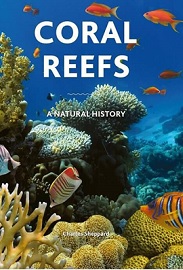Coral Reefs: A Natural History

Charles Sheppard
Princeton University Press, £28.00 (hardback)
This is a very well presented and beautifully illustrated book written by a leader in coral reef research, who has several coral reef books already to his name. What is different about this one? The key is in the sub-title – a natural history.
Natural history has many definitions, but one relevant here is that it involves enquiry into organisms in their natural environment, leaning towards observational rather than experimental methods of study. This is demonstrated in this book with hundreds of high definition colour photographs arranged into six chapters: The Coral Animal, Different Kinds of Reefs, How a Coral Reef Works, Local and Regional Disturbances to Reefs, Climate Change and Reefs, and People and Reefs.
What makes this book special is that each chapter is made up of illustrated two-page sections on cutting-edge topics related to reefs. They are written in delightfully clear and concise language that should appeal to any reader. A two-page limit on each topic means that the reader quickly acquires the headline areas of importance to coral reefs. While I would have liked references to scientific journal articles for at least some of the topics, there is a short section on books for further reading, and a g lossary.
The great delight of this book is both the wealth of illustrations, and the breadth of the topics considered, and it serves as an excellent and timely introduction to coral reef natural history, accessible to anyone who cares or wishes to learn about the marine environment in a human context and has the spirit of travel and adventure. This book captures the colour, variety and importance to humans of reefs that are declining even as we read the book.
Professor James Crabbe CBiol FRSB


